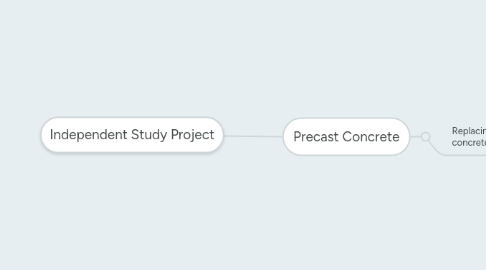
1. Precast Concrete
1.1. Replacing AWM mesh with fibre in concrete
1.1.1. Is this a suitable change in material?
1.1.1.1. Strength testing
1.1.1.1.1. Curing times
1.1.1.1.2. Comparable strength
1.1.1.2. Practical aspects
1.1.1.2.1. Quicker turnaround in factory
1.1.1.2.2. Less labour required to place mesh
1.1.1.2.3. Cost
1.1.1.2.4. Curing times
1.1.1.2.5. Sustainability
1.1.1.3. Components
1.1.1.3.1. Lattice planks
1.1.1.3.2. Solid planks
1.1.1.3.3. Twinwall
1.1.1.3.4. Solid wall
1.1.1.3.5. Megaplank
1.1.1.3.6. Columns
1.1.1.3.7. Beams
1.1.2. Why is this needed?
1.1.2.1. Limitations of AWM machine
1.1.2.1.1. High cost
1.1.2.1.2. Labour required
1.1.2.1.3. Turnaround time
1.1.2.1.4. Workload of factory increasing
1.1.2.1.5. Sustainability issues
1.1.2.2. Increase structural integrity of concrete
1.1.2.2.1. Increase tensile strength of concrete components
1.1.2.3. Reduce cracking of concrete
1.1.2.3.1. reduce amount of repairs required post cast
1.1.2.3.2. short, hair shaped fibres good for reducing cracking while concrete is stiffening
1.1.2.3.3. Plastic shrinkage cracking
1.1.2.3.4. Drying shrinkage cracking
1.1.2.4. Lower permeability of concrete
1.1.2.4.1. Increase durability
1.1.2.4.2. Increase resistance to freeze-thaw effects - good for infrastructure projects such as bridges
1.1.2.5. Can fibres increase flexural strength of concrete?
1.1.2.5.1. Generally not used to increase flexural strength - mainly for cracking purposes
1.1.2.6. http://theconstructor.org/concrete/fiber-reinforced-concrete/150/
1.1.3. What fibrous materials are available?
1.1.3.1. Steel fibres
1.1.3.2. Glass fibres
1.1.3.3. Synthetic fibres
1.1.3.4. Natural fibres
1.1.4. What is fibre reinforced concrete?
1.1.4.1. Short, Uniformly distributed, randomly orientated fibres cast into concrete
1.1.4.2. Varying concrete mixes can be used
1.1.4.3. Varying fibre materials
1.1.4.4. Varying densities of fibres
1.1.4.5. Varying orientation of fibres
1.1.4.6. Varying geometries of fibres
1.1.5. Tests
1.1.5.1. Specimens
1.1.5.1.1. Can make up cubes, cylinders, 100x100mm beams in house for testing
1.1.5.1.2. Cubes
1.1.5.1.3. Cylinders
1.1.5.1.4. Beams
1.1.5.2. Mix in house
1.1.5.2.1. Own batching plant. Access to steel and plastic fibres.
1.1.5.3. No flexural rig in house
1.1.5.3.1. Has university got a testing rig capable of testing fibreous concrete (higher strength)
